Marijuana News
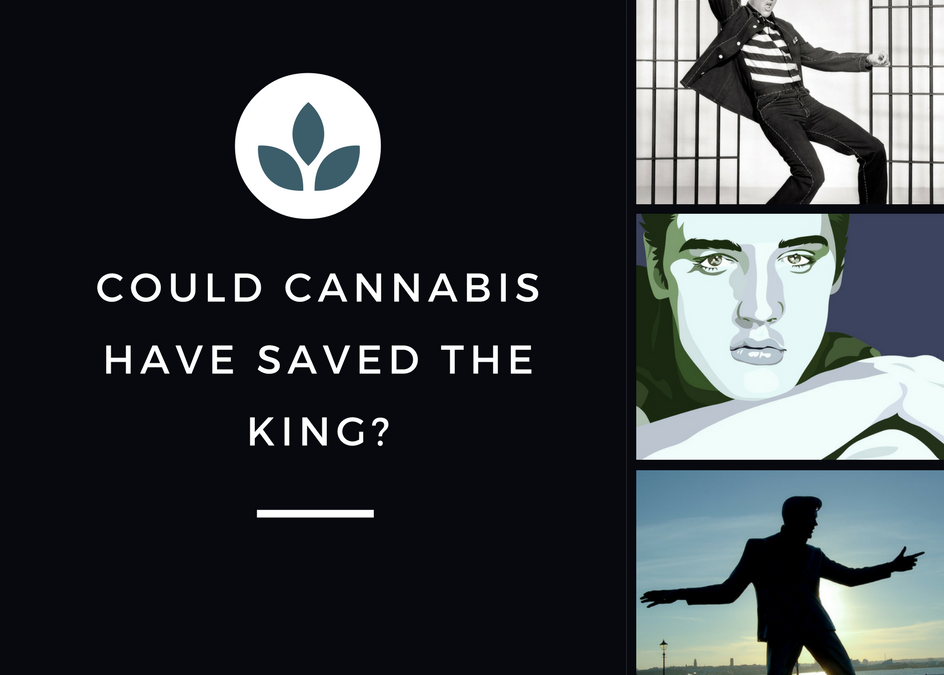
Could Medical Marijuana Have Saved Elvis Presley?
Elvis Presley is the undisputed King of Rock and Roll and one of the most significant icons in the history of American music. But unfortunately the tale of the fate of the King is a rather sad one. He suffered from drug abuse, health issues, failed relationships and his final days were miserable, lonely and ended at the ripe age of 42 due to a prescription drug overdose.
His death caused many to question what led this legend down such a dark path? And could a medical cannabis intervention have saved the King? To understand the answer to this question, we will take you back to the beginning, where the drug abuse all started.
It is said that Elvis began taking diet pills from his mother’s purse in his teenage years – this was his first taste of amphetamines, which were legal at the time.
But his regular use of amphetamines did not start until the late 50’s, after he was drafted into the army and his mother died of a heart attack. Soon after her death (which was a major blow to the star), he was sent to Friedberg, Germany – which is where the regular use began.
After his honorable discharge in 1960, things seems to go downhill for Presley. His films were panned by critics, but he continued performing. He married in 1967 and had a child soon after. Unfortunately, this blessing came during a time of deep depression for the star.
Anti-Drug
The most interesting part of all of this was Presley’s openness about being against drugs. A coworker of one of his films mentioned that she had smoked marijuana, and he apparently freaked out and told her to never do that again. His anti-drug mindset was so intense that he even met with President Nixon in 1970 to express his concern regarding the growing hippie movement. He even went so far as to call out the Beatles for their drug use – which was ironic because all the pop stars, including Elvis were using illegal drugs.
The Rise of Drug Use
A short year later, Elvis was having a year and planning his divorce, which ignited Presley’s paranoia. He was convinced that overexuberant fans that rushed onstage after his shows were actually contracted to kill him. And the blow from the finalization of the divorce hit him hard, leading to his first overdose in 1973.
In 1973, Elvis Presley overdosed on barbiturates and spent 3 days in a coma. And Elvis became severely addicted to a potent opiate – Demerol. But he did not seem concerned, he felt that he was not the everyday junkie getting something off the street, because it was prescribed.
Presley hired a live-in doctor, Dr. George Nichopoulos, who reports writing some 10,000 prescriptions during the final months of Elvis Presley’s life: uppers, downers, narcotics, opiates, and barbiturates.
The Effects of Presley’s Drug Use
Elvis developed an erratic onstage persona – slurring his words, clutching the microphone and occasionally the inability to perform.
His sleep schedule was also completely out of whack. He was unable to sleep for more than 3 or 4 hours before waking up, seeking more pills.
Alas, Elvis Presley died with a lethal combination of a dozen different drugs, most of which were prescribed. He felt justified in using his barbiturates because they were legally prescribed by a doctor, unlike cannabis, which could only be obtained from the underground black market.
Cannabis as an Alternative
If cannabis had been a legal alternative, it might have been able to help wean him off of his dependence on some of the other drugs that contributed to his demise. A heavy indica could have been used to help Elvis sleep, and there is growing evidence that cannabis can be used to reduce the use of opioids.
For your viewing and listening pleasure, we included a video of one of Elvis’ hits:

Using Cannabis For Sexual Pleasure
Marijuana and sex. You may not guess it, but they go together like marijuana and pizza. Doctors that specialize in medical marijuana are beginning to notice a surprising side effect from a light buzz. Patients that are prescribed marijuana for pain management, anxiety or other chronic conditions, are reporting that it’s helping in the bedroom too!
“We’ve known for a while, at least anecdotally, that cannabis can enhance the sexual experiences of women,” says Jordan Tishler, M.D., a Harvard-trained physician who now runs a cannabis clinic in Boston. But more recent findings from surveys show that both women and men had seen a boost in their sex life after taking marijuana.
What’s unusual is that traditional medicine literature does not back this; most of the studies on marijuana and sex (for males) say that it can cause problems in the bedroom for men.
But doctors that work with cannabis in the field disagree. They say that this traditional literature is completely out of date and new research needs to be conducted – the only problem is that academic research relies on federal grants (reminder that federal law prohibits marijuana), so it may be quite awhile until we can conduct more research on medical marijuana.
But in the meantime, some doctors will continue prescribing cannabis as a treatment for men suffering from lack of desire, erectile dysfunction and difficulty reaching orgasm. Even if it’s only making them feel more relaxed, that makes it easier for them to enjoy sex.
And even if it doesn’t work for you, cannabis might boost your lady friend’s sex life. Cannabis really enhances a woman’s sexual experience, and can make them feel more aroused.
If you’re interested in trying cannabis for sex, we recommend taking a quick look at this guide of cannabis for sex.
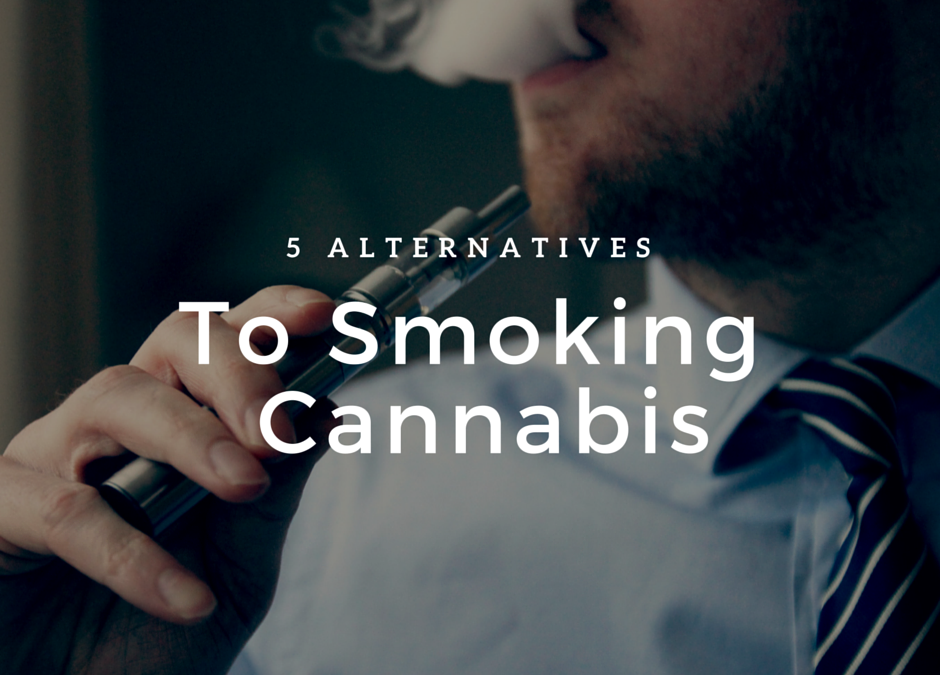
5 Ways to Use Marijuana Without Smoking
As cannabis becomes more and more normalized and accepted in society, we are becoming more and more aware of the medicinal benefits of medical marijuana. But what’s not so good for you? Smoking marijuana.
The combustion of cannabis fills your lungs with toxic compounds and irritants. Furthermore, it feels terrible in your throat, and although it gets you high quickly, it only lasts for an hour or two. So, we decided to share with you 5 other ways of consuming marijuana; so you get the medical benefits, but not the negative side effects.
1. Use Vaporizers
Vaporizers are so amazing because they reduce the smoke intake by up to 95%! Because the marijuana is burned at a lower temperature, there are much lower levels of tar and carcinogens that enter your body.
Additional perks: there is less resin buildup, so you can keep your pearly whites and you don’t get that nasty burnt taste like you did from the bong in college, plus there are some pretty classy vapes out there – so you can use in style!
Overall, experts agree that using a vaporizer is the healthiest way to consume marijuana.
2. Eat Edibles
Not only is this method more fun and enjoyable than smoking marijuana, it also saves your lungs and throat from all that coughing.
You can either buy edibles that are already made (from candy to baked goodies), or make them yourself – to do so, you’ll want to buy cannabis infused oil or butter.
Keep in mind though that it does take much much longer for you to feel edibles, so start with small doses and make sure that you don’t take too much!
3. Apply Topicals
With medical marijuana topicals, there is no risk for any potential psychoactive reactions, because they only work on your muscles and skin, not your mind. These products include lotions, salves, and creams and can relieve physical pain and reduce inflammation.
Topicals can also be used to speed up the healing time for small injuries such as: cuts, insect bites, and sunburns.
4. Use Tinctures & Tonics
Most people have never heard of “tinctures,” but ironically, they used to be one of the most common and trendiest ways of consuming marijuana. Tinctures are alcohol extractions of the cannabis plant and still contain all 80 of the essential cannabinoids, despite the extraction process being cheap and efficient. Furthermore, similarly to topicals, there is very little risk for users to experience any psychoactive effects, and you can have better dosage control. Therefore, there will not be a big “high” to wait for, like you’d experience with edibles.
The best way to use tinctures is to place a few drops underneath your tongue – or you can put a pinch in coffee or even apply it directly to your skin.
Those that find tinctures to be most beneficial are patients undergoing chemotherapy, treating muscle spasms and cramping and even epilepsy.
5. Beverages
If you want to keep it simple, you can pour hot water directly over the plant and let it steep for about a half an hour. You can also make cannabis coffee or chai tea! If you are more into the sodas… you can even purchase Canna Cola – who sells a variety of flavors, from grape ape to orange krush.
These alternatives are great for those who do not want the negative side effects of smoking marijuana. This is very appealing for a different crowd that does not want to be attached to the stigma of being a “stoner,” including: mothers, grandmothers, professionals and more.
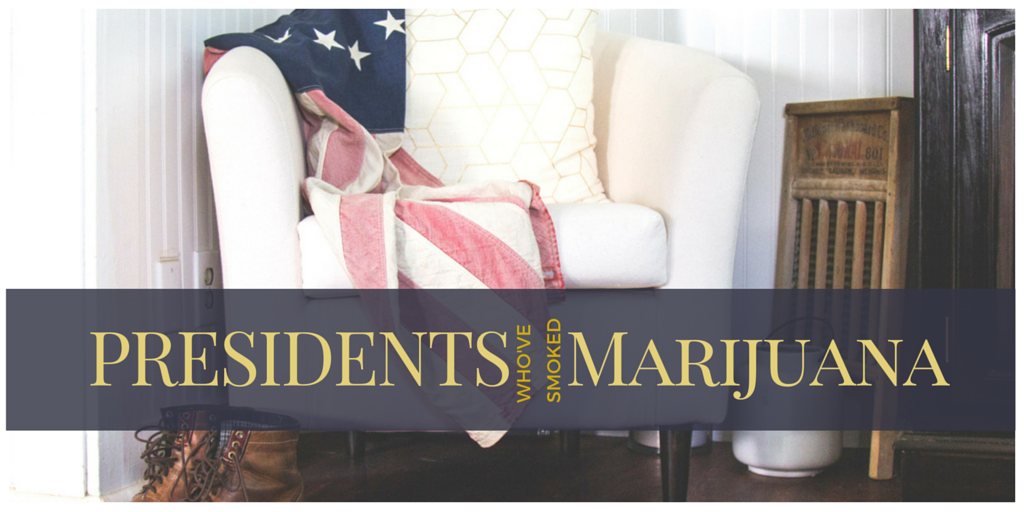
The Presidents That Admitted to Using Marijuana
13 of our very own United States Presidents have subtly, or not-so-subtly admitted to smoking or ingesting cannabis. So the countdown begins:
13. George Washington
Mr. Washington routinely smoked marijuana to reduce the pain caused by his ailing teeth. He even wrote in his journal about how to enhance and better cultivate his marijuana crops.
12. Thomas Jefferson
Jefferson grew cannabis on his plantation and smuggled Chinese hemp seeds to America. It is also believed that he may have given our smoking blends as personal gifts.
11. James Madison
Mr. Madison once (not-so-subtly) said that hemp gave him insight to create a new and democratic nation.
10. James Monroe
Monroe was a lifelong cannabis user – he began smoking when he was the Ambassador to France and continued his smoking until the age of 73.
9. Andrew Jackson
Jackson has been documented to have smoked cannabis and tobacco cigars along with the troops he led.
8. Zachary Taylor
Similarly to President Jackson, Taylor is said to have smoked with his fellow troops in at least one of the many wars he was in.
7. Franklin Pierce
Pierce was yet another American President that smoked marijuana while in war. In a letter he wrote to his family during the Mexican-American war, he said that cannabis was “about the only good thing” in the war.
6. Abraham Lincoln
You may have seen the photos and quotes all over the internet about Mr. Abe Lincoln toking up. Most of them are jokes, but most resources do agree that it is highly likely that he did, in fact, smoke marijuana.
5. John F. Kennedy
Many of Kennedy’s friends and acquaintances say that he regularly used cannabis, and some say he even planned on legalizing cannabis in his second term. He used marijuana to control his back pain.
4. Jimmy Carter
As you may know, Mr. Carter did make many efforts to legalize marijuana, but he is also known to have hosted many marijuana smoke-filled events at the White House – which naturally leads most to believe that he must have tried it at least once in his life.
3. George W. Bush
Although Bush publicly refused to answer the marijuana question, he was later caught saying that he refused to talk about it, “because I don’t want some little kid doing what I tried.”
2. Bill Clinton
The famous words of Mr. Clinton are that he smoked, but “didn’t inhale.” Since we all know that he has bent the truth in the past, we can safely assume that he still makes this list.
1. Barack Obama
Obama is probably the only president that has been very open about his past marijuana smoking. He even joked, “I inhaled frequently. That was the point.”
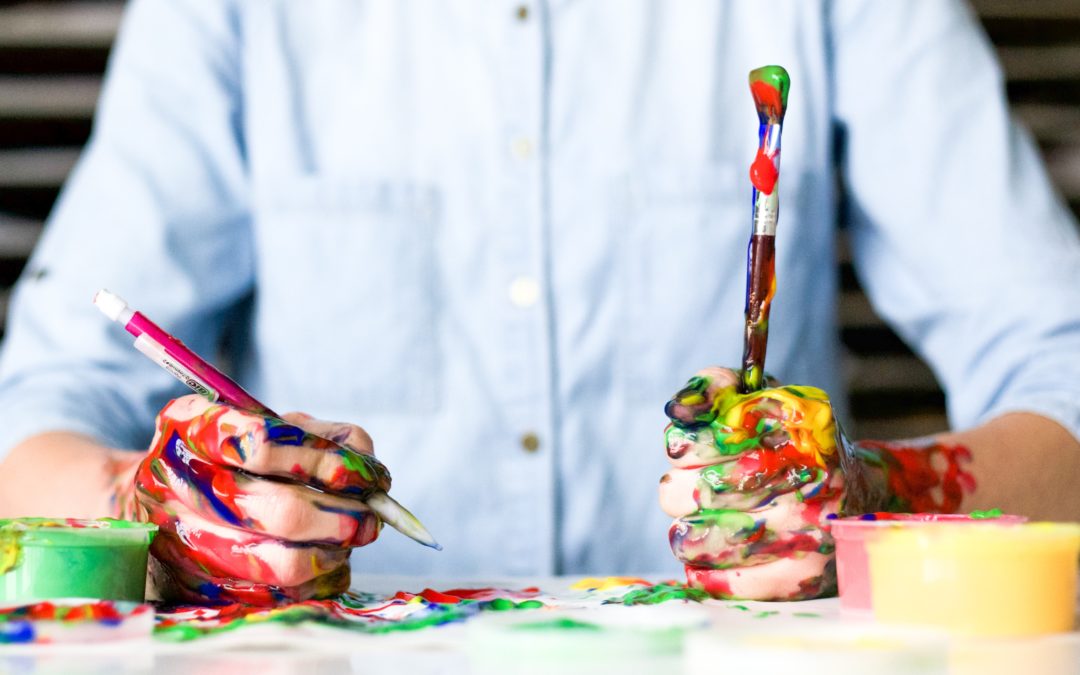
Does Marijuana Really Make You More Creative?
Creativity is a mindset. So those that say creativity is a gene that is passed down, and those born with an analytical mind aren’t capable of creative thinking are wrong. Anyone has the capacity to think creatively – to turn the ordinary into extraordinary – but some find this difficult.
Throughout history, we have tried to find the key to creativity. Some say we have found it. Some say that cannabis is the key to enhanced creativity. Is this true? Let’s find out.
Creativity. What is it?
What differentiates a creative person from a non-creative person? Creative people have a remarkable ability to adapt to unique situations and have the ability to take a leap of imagination that is different from the “norm” of society. While creatives still remain rooted in reality, they also alternate between the imagination and fantasy.
But even non-creative people can still enter a creative mindset – it just may be more difficult, and less common. But ultimately, creativity is a fairly simple brain alteration, which leads people to wonder what they can do to the brain to be more creative.
Cannabis & The Brain
The neurons in your brain process and pass along information in the form of neurotransmitters to the rest of the brain. After a neuron fires, there’s typically a break in the transmission of thought in order to not overwhelm the mind and keep you and your “in control,” and rooted in reality.
One of the natural transmitters to the neurons in your brain is called Anandamide and can be mimicked by Tetrahydocannabinol (THC), which can stop these breaks, thus allowing the cannabis user to amplify their ideas and imagination.
But don’t just take it from us. Others agree that cannabis can lead to an escape from the ordinary and creative thinking.
The Science Behind Cannabis Creativity
The author of Creativity and Beyond, Robert Weiner says that a cannabis-induced state of mind may in fact lead the user to break free from everyday thinking and analytical associations, thus increasing the chances of generating new ideas and associations.
And science proves this. The Berkeley Medical Journal shows us that cannabis has in fact been scientifically proven to help us generate new ideas, help break free of the constraints of current realities and to help stimulate creative drive.
So there you have it – when you get high, it might just be a good idea to keep a notebook near by, just in case you have a brilliantly creative idea.
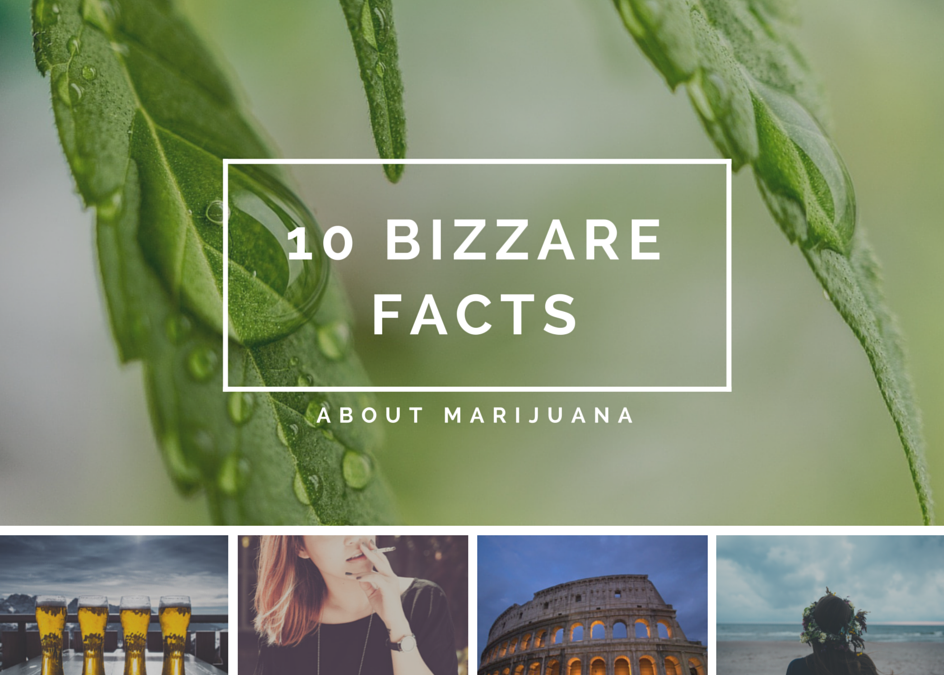
10 Facts About Marijuana You Never Knew
1. Hippies Did Not Discover Cannabis
The popular belief is that the hippie generation “discovered” pot. While the origins of cannabis remain a bit murky, we can assure you that the hippies did not discover weed.
The DEA says that the earliest recorded use of cannabis dates back to 2727 B.C when the Chinese Emperor Shen Nung, used it for its medicinal purposes. But there’s a problem with this – there never was an emperor named Shen Nung, and the first emperor of a unified China was Qin Shi Huang, who was born around 260 B.C..
But the ancient Chinese do deserve some credit, as there is evidence that the ancient Chinese did in fact use cannabis. If you find this interesting, you can read more about Ancient Marijuana use.
2. Marijuana Makes Good Rope & Fabric
Surprisingly, the marijuana plant can be used for more than just smoking and human consumption. The fibers of the marijuana plant, or hemp make a great material for rope and fabric. And for thousands of years, it was actually used to make rope.
Perhaps the oddest use of hemp rope on record is as a method for transporting giant stone statues. For years archaeologists tried to figure out how people moved the giant 9,600 pound statue on the Easter Islands from the stone quarry. Some suggested log rollers and other theorists suggested extraterrestrial assistance. But in 2012, they proved that the team of transporters used hemp rope.
3. Hemp and Marijuana are Different
Industrial hemp plants are the same species as marijuana plants. However, a single genetic switch results in a the production of tetrahydrocannabinolic acid (THCA), the precursor to tetrahydrocannabinol (THC), which gets you high. Hemp plants lack the gene that produce THCA.
However, both hemp and marijuana plants do contain cannabidiolic acid (CBDA), the precursor to CBD – which is non-psychoactive. CBD does however have some medicinal qualities.
4. Men & Women Experience Different Effects of Marijuana
Consuming marijuana could very well provide a very different experience for women than men. A 2014 study from the journal, Drug and Alcohol Dependence found that female rats were more sensitive to the painkilling qualities of cannabis. They were also more likely to develop a tolerance for the drug, which could contribute to negative side effects and dependence on marijuana.
The female hormone, estrogen seems to be the reason behind these sex-specific effects, because the females were more sensitive to the effects of cannabis at ovulation, when estrogen levels are highest.
5. Our Pets Can Use Marijuana Too
While we use medical marijuana for everything from glaucoma to PTSD, not many have considered marijuana for dogs in the past. But similarly to humans, dogs find comfort in CBD. It can help relieve anxiety during thunderstorms, or it can relieve the side effects of cancer treatments.
Although vets are not yet prescribing marijuana to dogs, many understand why their owners use marijuana for their dogs, and do not prohibit them from doing so. Here is more about Dogs & Cannabis.
6. Bizarre Strain Names – They’re Tradition
A wine lover might choose between a pinot noir, a sangiovese and a cabernet to go with dinner. A pot connoisseur, on the other hand, could choose between strains with names like “purple haze,” ” Redwood Kush” and “green crack.”
Believe it or not, unusual, goofy names are a time-honored tradition among marijuana growers, going back at least to the 1970s, when strains such as “Maui Waui” (from Hawaii, naturally) came into the scene. Why such goofy names? Well, one reason might be the process behind the naming decisions. Often times it takes quite awhile to develop a strain – you’d think you’d have enough time to come up with a name.
But usually the growers are so caught up in developing and growing the marijuana strain that when it’s all done, they have no idea what to call it – so they have a brainstorming session. They smoke a bowl with their friends and come up with a “creative” name.
And now, it has just become tradition.
7. Cannabis Is in the Air
You might expect to find a haze of pot smoke at a Wiz Khalifa concert at Red Rocks, or a marijuana yoga session, but on the streets of Rome?
According to a 2012 study in Rome, there are trace amounts of marijuana in the air. But it wasn’t just Rome – it was seven other cities. But if you’re not a smoker, or have kids, don’t worry, you can still take your Italian vacation; the levels of marijuana and other substances were far too low to affect human health.
8. Producing Marijuana Isn’t All That “Green”
Marijuana plants may be green in color, but producing marijuana is far from sustainable. The energy needed to produce 2.2 pounds (1 kilogram) of marijuana indoors is equivalent to that needed to drive across the country five times in a car that gets 44 miles to the gallon, according to a 2011 report by a researcher at Lawrence Berkeley National Laboratory. Why? Grow lights require A LOT of electricity.
Because of the year-round demand of marijuana, growers must grow their marijuana in greenhouses, rather than outside. Growing outside would also require more pesticides and things like rat poison to keep the animals away.
9. Marijuana Has Been Found in Babies – Sort of
A hospital in North Carolina noticed a rather large number of newborns testing positive for marijuana in their urine – this causes concern as it can indicate that they mother has been smoking pot.
But it turns out that these babies were not actually suffering from marijuana exposure and their mothers were not smoking marijuana during pregnancy. What they found instead is that several ingredients in baby soaps can cause a false positive on urine tests for marijuana. The soaps don’t actually contain marijuana or get the babies high.
10. Beer & Cannabis Are Related – Sort of
The hops used to make beer are in the same family of flowering plants as marijuana – resulting in several similarities.
The Humulus lupulus (hops) and Cannabis sativa (marijuana) have similar organoleptic properties, meaning they produce a similar taste and smell.
Further, the major bitter compound in hops, the so-called alpha acids, aka humulone, is a terpenoid (derived from terpenes). The primary active ingredient in that dank you’re smoking, the tetrahydrocannabinoids, are also terpenoids. Many other plants produce terpenoid compounds that produce distinct smells and tastes, but none of them resemble that of cannabis and hops.
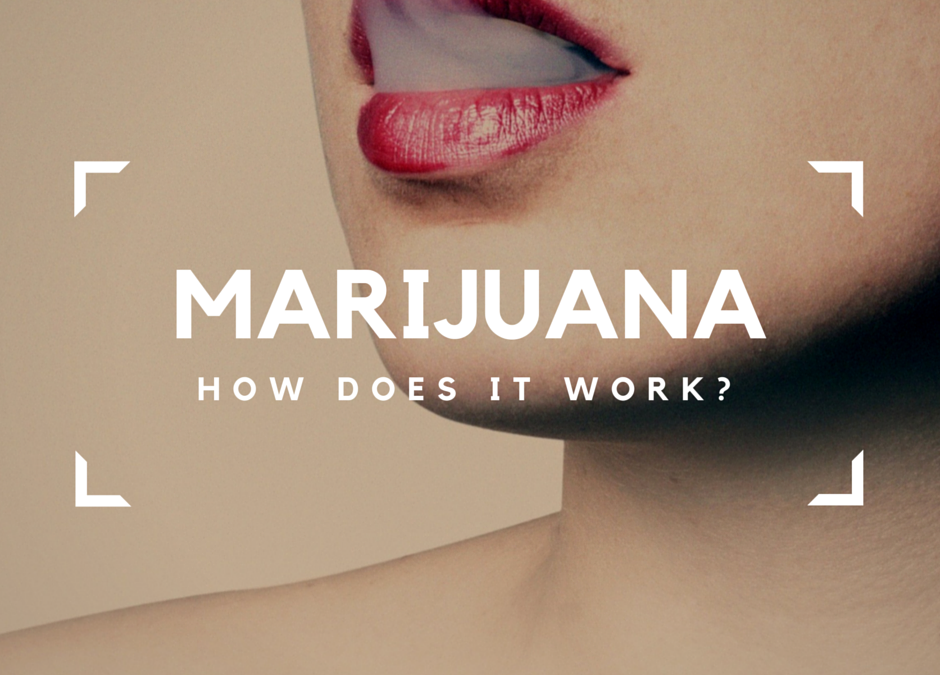
Marijuana in the Body and Brain
We are all familiar with the concept and affects of being high. But what many people don’t know is why we feel that way. How does marijuana make you feel high? What is the science behind feeling this way? And does medical marijuana work the same way? Here, we explain, simply how marijuana affects our brain, and our body. So, how does marijuana work?
In order to understand how marijuana affects the brain, we must first understand how it relates to our bodies and our brains.
What’s the Endocannabinoid System (ECS)?
This is what you might of heard as the body’s own cannabinoid system. It is a group of cannabinoid receptors (most of which are located in the brain) and throughout the rest of the central nervous system and the peripheral nervous system.
What does it do? It plays a role in the regulation of things like: mood, memory, the sensation of pain, physiology, and appetite. While it performs many tasks, its main goal is to provide your body with homeostasis and an overall healthy and stable environment.
There are two primary cannabinoid receptors: CB1 and CB2.
What’s the Difference Between CB1 and CB2 Receptors?
CB1 receptors are predominantly found in the brain and nervous system (and occasionally found in other organs and connective tissues). The CB1 is the main receptor for THC. The psychoactive effects of cannabis are a result of THC activating CB1 receptors.
CB2 receptors are primarily found in the immune system and its affiliated structures. They take on the responsibility of modulating the anti-inflammatory effects of cannabis. Essentially CB2 acts as an immune response – which could be very important in medical marijuana, as inflammation is a significant factor in many diseases.
What Are Cannabinoids?
Cannabinoids are chemical compounds that interact with the brains’ receptors. There are at least 85 cannabinoids that can be found in cannabis. Because of the hype of cannabis and marijuana legalization, the cannabinoids that most people are familiar with are THC and CBD.
What is CBD?
Unlike THC, CBD does not have psychoactive effects. It is THC’s non-psychoactive cannabinoid sibling that does not seem to bind to CB1 or CB2. So how does it work?
Instead, CBD seems to indirectly stimulate cannabinoid signaling by suppressing the enzyme that breaks down THC’s “twin,” called anandamide – thus explaining why CBD can counteract some of the effects of THC.
But like THC, it also seems to play a role in appetite, the immune system, and especially pain management.
What is THC?
THC is the cannabinoid that is responsible for the psychoactive effects of marijuana. It affects the brain by activating the brain’s cannabinoid receptors (primarily CB1). Because it affects the brain, it can promote creativity, can amplify your thoughts and can even help you focus.
THC in the Body
THC is a phytocannabinoid (phyto means “of the plant”) that activates the CB1 receptor, resulting in a psychoactive effect. The “twin” of THC that is found in our bodies is called anandamide – which is one of our body’s naturally occurring cannabinoids. THC essentially mirrors this cannabinoid.
THC Dosage is Important
Cannabinoids, and THC in particular, has a biphasic effect – this means that low and high doses can have opposite effects in users. Thus, this explains why many people feel relaxed when taking low doses of cannabis and paranoid under such high doses. Furthermore, the effects of cannabis are highly dependent on the individual and the method of preparation (eg. Edibles, vaping etc.).
This also depends on an individual’s lifestyle preferences. Some may want to feel drowsy and relaxed, while others may prefer to feel energetic and happy.
Another aspect that will affect the effects of cannabis are the THC to CBD ratios – which vary dramatically from strain to strain.
OPTIMAL Doses (Low to Moderate) and the Effects:
Elevated mood, euphoria
Relaxation
Sleepiness (although, higher CBD concentrations can counteract this effect)
Increased levels of energy
Increased creativity
Blocked detection of pain
Appetite stimulation
High Doses and the Effects:
Hallucinations (varies from mild to moderate)
Paranoia
Anxiety
Disorientation
Heightened pain sensitivity

Why The Cannabis Business Is Appealing to Women Entrepreneurs
In the mountain town of Denver, Colorado, which began allowing the recreational sale of cannabis in 2014, businesswomen and female entrepreneurs say that they are launching cannabis-centric businesses with the hope that they can avoid the glass ceiling – which some say prevented them from reaching their desired salaries and corner offices.
In the past several years, women have become a driving force in the growth of the cannabis industry here and across the United States. And the world is taking notice, as apparent by this magazine cover that recently proclaimed, “Legal marijuana could be the first billion-dollar industry not dominated by men.”
But it’s not just magazine covers representing this trend, the numbers do too. According to Marijuana Business Daily, women make up roughly 36 percent of executives in the legal marijuana industry, compared to just 22 percent of senior executives in other industries and just 4.2 percent of CEO positions at S&P 500 companies.
This could be a great, new chance for women that have been in the corporate world who couldn’t get to the next level, or the desired level. The industry itself is breaking old traditions – so it makes sense it is more likely for women to break old gender traditions too.
“It’s a chance for women to break the rules”
Not only does this industry offer women the chance to break the glass ceiling, but it offers its workers more flexibility than the alternative – like finance. This gives women more time to spend with their family and friends.
Market Openings
Some women are also entering this industry because they see market openings and strategies that men seem to have overlooked. Take this cannabis product line as an example. They have introduced a luxury line, so women feel more comfortable using cannabis, from purchase to use. Another example is described in this podcast, where this female entrepreneur opened her own, low-calorie, “healthy” edibles line.

Research on Cannabis as Melanoma Treatment
A country with the highest rates of skin cancer in the world is beginning to explore using cannabis to treat melanoma. Researchers at the University of Canberra of the Australian Capital Territory (ACT) will soon be collaborating with a pharmaceutical company to test medical marijuana as a melanoma treatment.
There are nearly 55,000 Australians currently living with skin cancer, that can benefit from this research. As noted, Australia has the highest rates of skin cancer in the world; molecular and cellular biology professor Sudha Rao says that she estimates over 13,000 new diagnoses in 2016 alone, and nearly 1,800 people will die this year as a result of skin cancer this year. Therefore it is obvious that we need to be working harder at finding skin cancer treatments – we at least owe it to these 55,000 just in Australia, alone.
Professor Rao, will be one of the researchers on this project. She has previously worked on preventing the recurrence of breast cancer and other aggressive cancers, but has since turned her attention to melanoma, because of how many people it is affecting.
Medical cannabis could provide a treatment for the actual melanoma, itself. Worst case scenario, it can provide patients comfort from the effects of cancer and chemotherapy.
The University of Canberra just announced a $1 million deal with an Israel-based pharmaceutical company, called Cann Pharmaceutical, who will provide specific strains of medical-grade cannabis. These strains will be administered to melanoma patients – in addition to their current standard care and treatments for melanoma.
The cannabinoids will be administered to patients along with chemotherapy. Following this, researchers will monitor the impact on the melanoma stem cells of the patients.
First things first, the strains of medical marijuana will need to be developed by Cann Pharmaceuticals – after all, the cannabis is essential to the research. The trials should begin in Australia’s capital of Canberra next year.
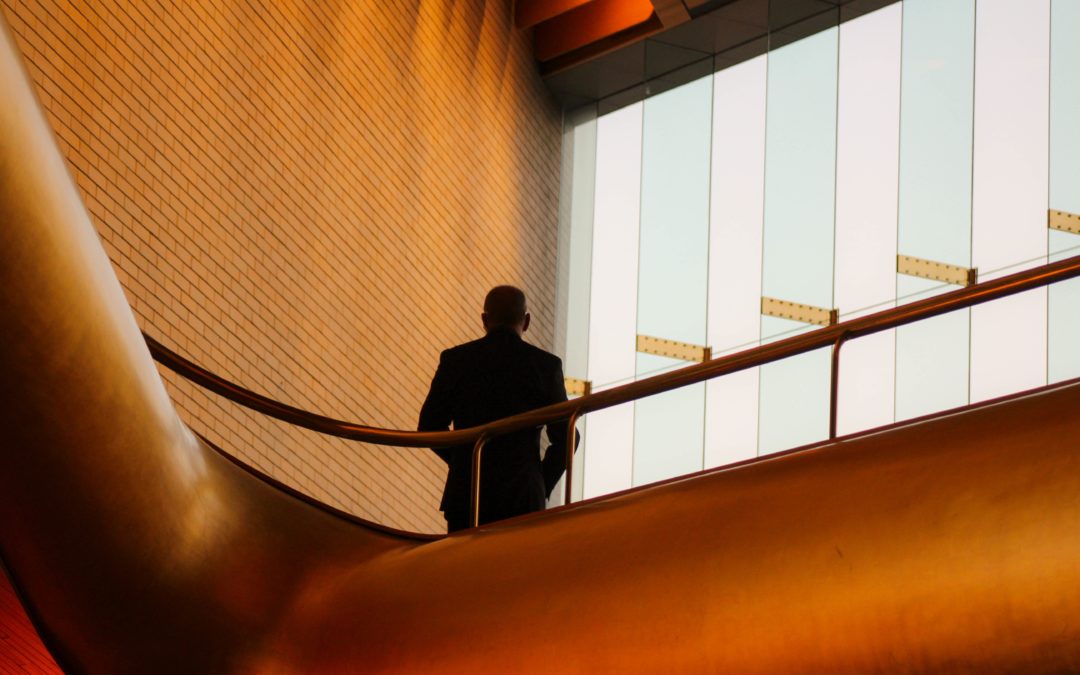
Corporate Cannaphobia
Although Corporate America seems to be warming up to the cannabis industry, corporate cannaphobia has not yet vanished. Despite the grand economic opportunity of the cannabis industry, many other industries and companies are shunning cannabis.
This is especially the case among social media giants, such as Facebook and Instagram, who have shuttered cannabis-related accounts. Banks and insurance companies are literally turning away cannabis clients every single day. Even the education system is shunning cannabis.
All of the above has ramifications for the industry itself, for research on cannabis and on properly education users and the community as a whole.
Digital marketing has become a necessity for any successful business – but marijuana companies lack the ability to utilize many social media platforms, such as Facebook.
A lack of insurance means that if a plant gets mold, you must throw out the whole crop – and throw out all that money.
No banking means no [accurate] audits. So how do you determine how much money your business is really making? Because marijuana dispensaries operate using cash, it seems like they are rolling in the dough…after all, there is a safe full of cash sitting in front of you. Not only does this attract theft, but it also deceives dispensary owners. With all the costs, you many not actually have as much cash as you think. And what’s the point in trying to find ways to reduce your costs if you don’t realize how high they are?
But all of these factors aren’t halting or even hurting the industry. It continues to thrive and grow. Those that are still trying to hold it back, and deny that it has medical benefits and claim that it is dangerous to use, should instead see that the growth and normalization of the cannabis industry is inevitable – so it might be time to focus on education and regulation.
Ultimately cannaphobia (of all types) results in a lack of knowledge. For cannabis business owners, this translates to a lack of knowledge about one’s own business. For the rest of the community, medical patients and users, this translates to a lack of knowledge and education about the product, itself.
As a result of the marijuana stigma, and the case that it is still classified as a Schedule I Substance, there is an extreme lack of funding for marijuana research. Thus, there is an extreme lack of research. Unlike most medications, most people do not know how much cannabis to ingest, or what kind in order to treat their problem, whether it be PTSD, epilepsy or chronic pain.
In general, there is not sufficient research to strongly conclude much about marijuana; most will admit this, including the NFL scientists, and even politicians against marijuana.
However, it seems as though this stigma is beginning to change. And it is also changing in Corporate America. Just last week, this little company you may have heard of called Microsoft, partnered with a marijuana business. Other companies are beginning to use cannabis as a means of branding and advertising. Now that a few of the major players have come out and accepted the cannabis industry, others are sure to follow.
As this stigma changes, we can only hope that the government will allow more research, so we can properly educate ourselves about this growing industry, and about cannabis, itself.

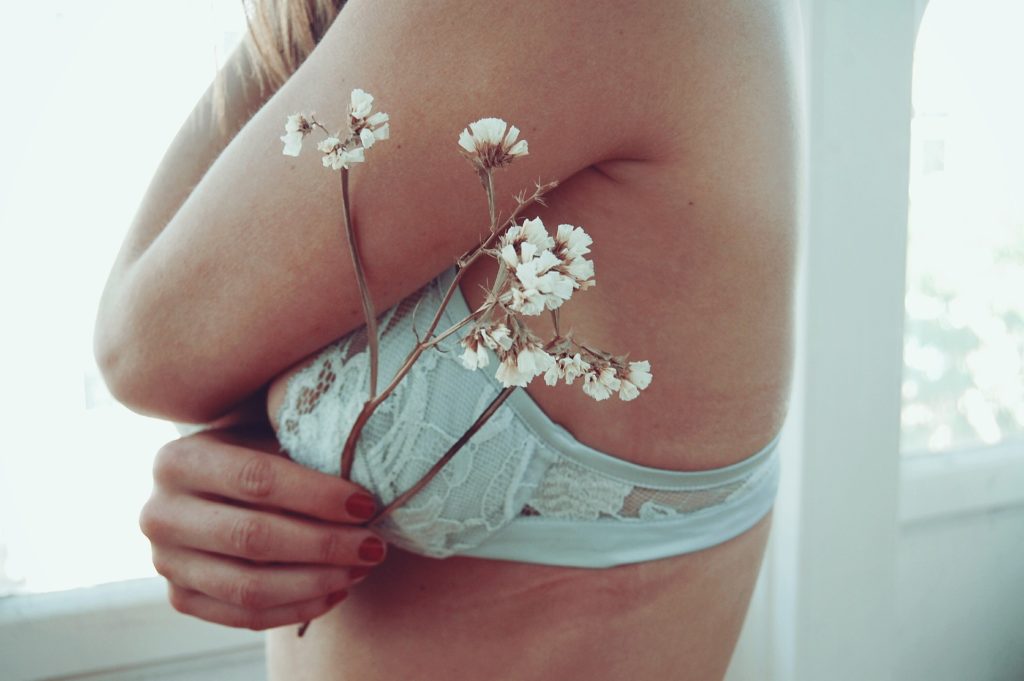
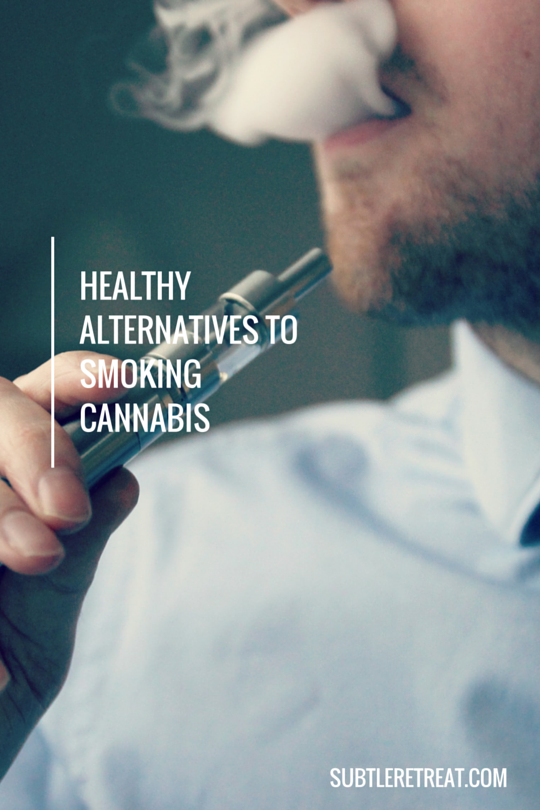
Recent Comments